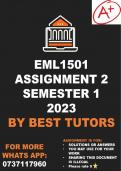, QUESTION 1.
1.1 The common thread between emergent speaking, emergent reading, and emergent
writing is that they all represent the developmental stages of language acquisition, which
are interconnected and contribute to the overall development of literacy skills in a child.
a. Emergent speaking is the earliest stage where children start to imitate sounds and
words they hear around them, engaging in playful vocal exploration. Through this, they
develop basic phonological awareness, vocabulary, and syntax understanding, forming a
foundation for the subsequent stages of literacy.
b. Emergent reading is when children begin to comprehend that written symbols
correspond to spoken words. They start to recognize familiar words or letters, and with the
help of their speaking abilities, they start making connections between the spoken and
written language, further enhancing their understanding of language structure.
c. Emergent writing comes after the child has some basic understanding of language
through speaking and reading. Here, they start to understand that they can communicate
their thoughts and ideas by putting words on paper. The development of this skill relies on
the previously developed skills of speaking and reading.
All these stages are not mutually exclusive but rather intersect and reinforce each other in
the process of literacy development. They all contribute to a child's emergent literacy by
helping them understand and effectively use language.
1.2 Parents can promote print awareness at home in numerous ways. They can start by
labeling common household items with their names, helping children make a connection
between the object and the corresponding word. They can read storybooks aloud, pointing
at words as they read, which helps the child recognize the word and its meaning.
Encouraging children to "write" grocery lists, notes, or draw pictures and describe them
can also foster print awareness. Additionally, parents can engage children in discussions
about various signs or logos they encounter in their environment, thus helping them
understand that print carries meaning.
1.3 Developmentally appropriate materials are crucial in a Grade R classroom because
they cater to the current cognitive, emotional, and physical abilities of the children. They
support children's natural curiosity and encourage active learning while promoting critical
thinking and problem-solving skills. For example, books with large print and colorful
pictures cater to their visual learning stage, fostering a love for reading. Similarly, blocks
and shape sorters can be used to enhance motor skills while also teaching shapes, colors,
and spatial relations. A pretend-play corner with costumes and puppets can promote




